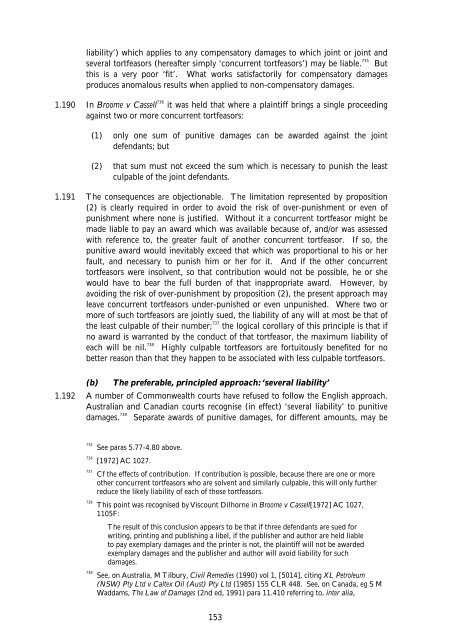Aggravated, Exemplary and Restitutionary ... - Law Commission
Aggravated, Exemplary and Restitutionary ... - Law Commission
Aggravated, Exemplary and Restitutionary ... - Law Commission
You also want an ePaper? Increase the reach of your titles
YUMPU automatically turns print PDFs into web optimized ePapers that Google loves.
liability’) which applies to any compensatory damages to which joint or joint <strong>and</strong><br />
several tortfeasors (hereafter simply ‘concurrent tortfeasors’) may be liable. 735<br />
But<br />
this is a very poor ‘fit’. What works satisfactorily for compensatory damages<br />
produces anomalous results when applied to non-compensatory damages.<br />
1.190 In Broome v Cassell 736<br />
it was held that where a plaintiff brings a single proceeding<br />
against two or more concurrent tortfeasors:<br />
(1) only one sum of punitive damages can be awarded against the joint<br />
defendants; but<br />
(2) that sum must not exceed the sum which is necessary to punish the least<br />
culpable of the joint defendants.<br />
1.191 The consequences are objectionable. The limitation represented by proposition<br />
(2) is clearly required in order to avoid the risk of over-punishment or even of<br />
punishment where none is justified. Without it a concurrent tortfeasor might be<br />
made liable to pay an award which was available because of, <strong>and</strong>/or was assessed<br />
with reference to, the greater fault of another concurrent tortfeasor. If so, the<br />
punitive award would inevitably exceed that which was proportional to his or her<br />
fault, <strong>and</strong> necessary to punish him or her for it. And if the other concurrent<br />
tortfeasors were insolvent, so that contribution would not be possible, he or she<br />
would have to bear the full burden of that inappropriate award. However, by<br />
avoiding the risk of over-punishment by proposition (2), the present approach may<br />
leave concurrent tortfeasors under-punished or even unpunished. Where two or<br />
more of such tortfeasors are jointly sued, the liability of any will at most be that of<br />
the least culpable of their number; 737<br />
the logical corollary of this principle is that if<br />
no award is warranted by the conduct of that tortfeasor, the maximum liability of<br />
each will be nil. 738<br />
Highly culpable tortfeasors are fortuitously benefited for no<br />
better reason than that they happen to be associated with less culpable tortfeasors.<br />
(b) The preferable, principled approach: ‘several liability’<br />
1.192 A number of Commonwealth courts have refused to follow the English approach.<br />
Australian <strong>and</strong> Canadian courts recognise (in effect) ‘several liability’ to punitive<br />
damages. 739<br />
Separate awards of punitive damages, for different amounts, may be<br />
735 See paras 5.77-4.80 above.<br />
736 [1972] AC 1027.<br />
737 Cf the effects of contribution. If contribution is possible, because there are one or more<br />
other concurrent tortfeasors who are solvent <strong>and</strong> similarly culpable, this will only further<br />
reduce the likely liability of each of those tortfeasors.<br />
738 This point was recognised by Viscount Dilhorne in Broome v Cassell[1972] AC 1027,<br />
1105F:<br />
The result of this conclusion appears to be that if three defendants are sued for<br />
writing, printing <strong>and</strong> publishing a libel, if the publisher <strong>and</strong> author are held liable<br />
to pay exemplary damages <strong>and</strong> the printer is not, the plaintiff will not be awarded<br />
exemplary damages <strong>and</strong> the publisher <strong>and</strong> author will avoid liability for such<br />
damages.<br />
739 See, on Australia, M Tilbury, Civil Remedies (1990) vol 1, [5014], citing XL Petroleum<br />
(NSW) Pty Ltd v Caltex Oil (Aust) Pty Ltd (1985) 155 CLR 448. See, on Canada, eg S M<br />
Waddams, The <strong>Law</strong> of Damages (2nd ed, 1991) para 11.410 referring to, inter alia,<br />
153
















